Chinese scientists' pursuit of cosmic rays opens windows on universe
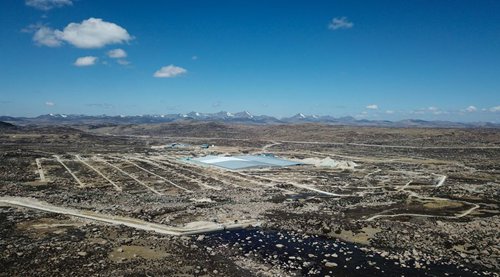
Aerial photo taken on April 27, 2019 shows the construction site of the Large High Altitude Air Shower Observatory (LHAASO) in Daocheng County, southwest China's Sichuan Province. (Xinhua/Jin Liwang)
In the wilderness of Daocheng, southwest China's Sichuan Province, 4,400 meters above sea level, Chinese scientists are constructing a cosmic ray observation station on an area equivalent to 200 soccer fields.
Huge rocks left from the Ice Age have been blasted. Different detectors are being installed to form a huge "net" to catch the particles generated by cosmic rays in the atmosphere, to help scientists study both the micro and the macro worlds in the universe.
Three huge underground pools, more than triple the size of the Water Cube (National Aquatic Center) in Beijing, will hold detectors to collect high-energy photons generated by remote celestial bodies. Surrounding the pools, 12 telescopes will be erected to conduct high-precision measurement of cosmic rays with the highest energy.
Construction of the first half of the observation station, known as Large High-Altitude Air Shower Observatory (LHAASO), is due to be finished at the end of this year, and the whole project completed at the end of 2020, said Cao Zhen, chief scientist of LHAASO and a researcher at the Institute of High Energy Physics (IHEP) of the Chinese Academy of Sciences.
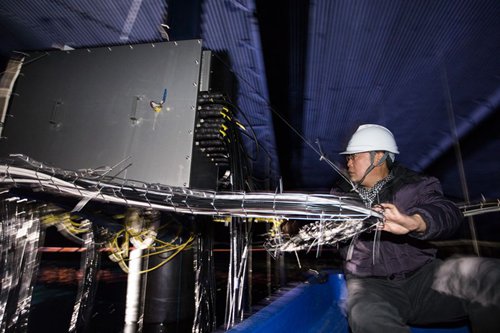
Researcher Cao Zhen from the China Academy of Sciences, chief scientist of the Large High Altitude Air Shower Observatory (LHAASO), checks the maintenance status of water Cherenkov detectors in Daocheng County, southwest China's Sichuan Province, April 28, 2019. (Xinhua/Jin Liwang)
CENTURY-LONG ENIGMA
Discovered in 1912, cosmic rays are still largely an enigma. They are direct samples of matter from outside the solar system. Physicists are still pondering where they come from and how they can be accelerated to ultra-high energies.
Now scientists have found most cosmic rays are atomic nuclei. All the natural elements in the periodic table are present in cosmic rays. About 90 percent of them are the nuclei of hydrogen (protons); about 9 percent are helium nuclei (alpha particles); and the other heavier elements, electrons, gamma rays, neutrinos and antimatter particles make up the other 1 percent.
Since most cosmic rays are charged, their paths through space are deflected by magnetic fields. On their journey to Earth, the magnetic fields of the galaxy, the solar system, and the earth scramble their flight paths so much that we can no longer know exactly where they came from.
Many countries have invested heavily in the study of cosmic rays. China, the United States, Russia, Japan, Germany and other countries have established observation stations.
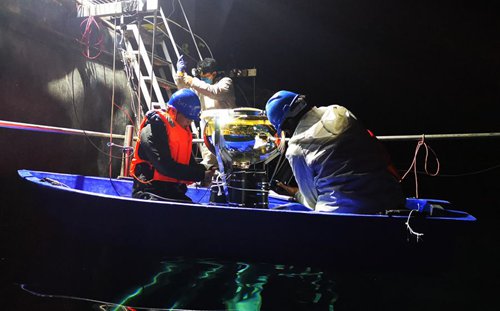
Photo provided by the Institute of High Energy Physics of the Chinese Academy of Sciences shows technicians working at the Large High Altitude Air Shower Observatory (LHAASO) in Daocheng County, southwest China's Sichuan Province. (Xinhua)
CHINA'S EXPLORATION PATH
China's cosmic ray detection began in the early 1950s. Chinese scientists built the country's first cosmic ray observatory on a 3,200-meter-high mountain in southwest China's Yunnan Province. Its scientific equipment was advanced by international standards at the time.
However, the "Cultural Revolution" from 1966 to 1976 hindered the research. When Chinese scientists returned to the study, they found they lagged far behind their peers abroad.
After China launched its reform and opening-up, Tan Youheng, a researcher with the IHEP, went to study in Japan. He was inspired by the air shower array technology for cosmic ray detection, and determined to conduct similar work in China.
After returning to China, he applied to build a world-class cosmic ray observation base.
Under the leadership of Tan and other scientists, China began to build an international cosmic ray observatory in Yangbajing Town, Tibet, at an altitude of 4,300 meters, in 1989.
Chinese scientists have since cooperated with Japanese and Italian scientists to conduct observations in Yangbajing.
This year, the China-Japan collaboration discovered the highest-energy cosmic gamma rays ever observed, opening a new window on the extreme universe.
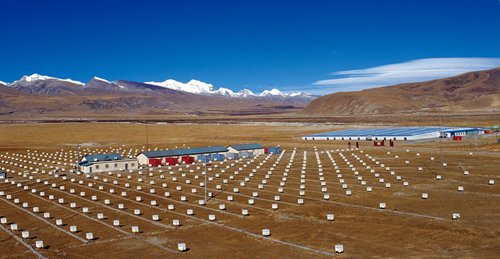
Photo taken on May, 2013 shows the ASgamma Experiment in Yangbajain, southwest China's Tibet Autonomous Region. A joint research team made up of Chinese and Japanese scientists has discovered the highest energy cosmic gamma rays ever observed from an observatory in Tibet, opening a new window to explore the extreme universe. (The Institute of High Energy Physics of the Chinese Academy of Sciences/Handout via Xinhua)
"Without national development, we would not have the funds to develop the technology," said Huang Jing, a researcher at IHEP and a spokesperson for the project.
WORLD-LEADING OBSERVATORY
When Cao Zhen was working in Yangbajing, he began to draw up a plan for a new-generation cosmic ray observation base. He aimed to make it a world-leading observatory.
He and his team spent five years investigating potential sites in Tibet, Qinghai, Yunnan and Sichuan.
Daocheng was eventually chosen due to its high altitude, convenient transport, stable power supply, sufficient water resources and support from the local government.
Infrastructure construction started in July 2016, and the building of the observatory officially began in June 2018.
The main objective of LHAASO is to search for the origin of cosmic rays, and study their acceleration and transmission mechanisms, said Cao.
In the second huge pool of LHAASO, which is 5 meters below ground, water Cherenkov detectors have been installed to form an array, and they will be submerged in 100,000 tonnes of the purest water in the world.
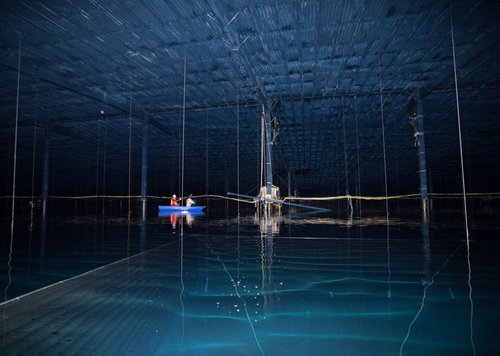
A researcher and a worker maintain water Cherenkov detectors in Daocheng County, southwest China's Sichuan Province, April 28, 2019. (Xinhua/Jin Liwang)
"The water comes from nearby lakes and rivers and has gone through strict purification. Only transparent pure water can make the detectors catch the signals generated by high-energy particles clearly," said Chen Mingjun, deputy director of the Cherenkov detector array.
After being on the plateau for a year, Chen lost more than 15 kg due to the hard work, but he said he is lucky to participate in such a grand project.
Foreign peers have been amazed at the speed of LHASSO's construction. It's not only a result of the scientists' efforts, but also of the complete industrial production capacity of China. It's the embodiment of China's overall national strength, said Cao.
He said the LHASSO project has drawn world attention. Scientists from Russia, Switzerland, Poland, the Czech Republic and other countries hope to bring their scientific equipment to the observatory.
Research teams from Australia and Thailand and other countries will participate in the project directly. Some well-known international research teams expressed the desire to conduct cooperation and joint observation with LHASSO, said Cao.
"After completing the LHASSO project, China is expected to lead the world in the field of cosmic ray research," Cao said.